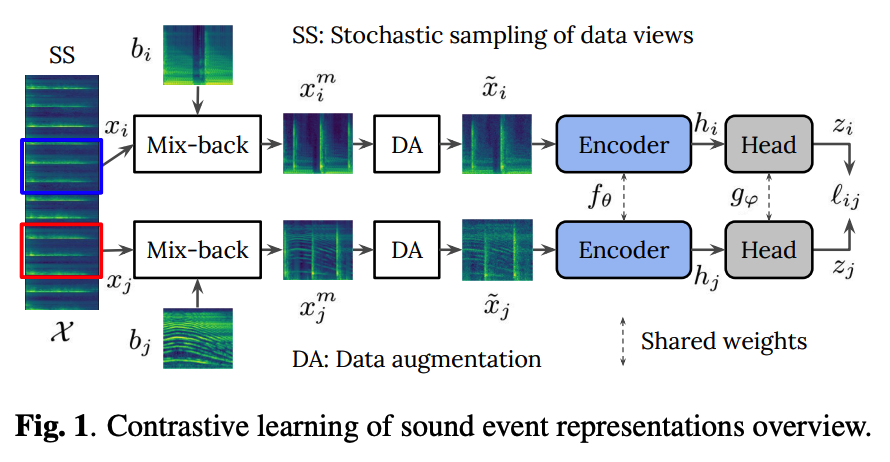Unsupervised Contrastive Learning of Sound Event Representations (arXiv, 2020)
https://arxiv.org/pdf/2011.07616.pdf
Contents
- Abstract
- Introduction
- Method
- Stochastic sampling of data views
- Mix-back
- Stochastic Data Augmentation
- Architectures
Abstract
Unsupervised contrastive learning as a way to learn sound event representations
Propose to use the pretext task of contrasting differently augmented views of sound events
-
views are computed primarily via mixing of training examples with unrelated backgrounds,
followed by other data augmentations.
1. Introduction
Sound event recognition (SER)
Two largest labeled SER datasets
- (1) AudioSet
- provides a massive amount of content but the official release does not include waveforms, and the labelling in some classes is less precise
- (2) FSD50K
- consists of open-licensed audio curated with a more thorough labeling process,
- but the data amount is more limited.
Related works in SSL
(1) First works in SSL sound event representation learning [7]
- adopting a triplet loss-based training by creating anchor-positive pairs via simple audio transformations
- e.g., adding noise or mixing examples.
(2) Predicting the long-term temporal structure of continuous recordings captured with an acoustic sensor network [12]
(3) Two pretext tasks [11]
- a) estimating the time distance between pairs of audio segments
- b) reconstructing a spectrogram patch from past and future patches
Proposal
pretext task of contrasting differently augmented views of sound events
- different views = via mixing of training examples with unrelated background examples, followed by other data augmentations.
Experiments
- linear evaluation
- two downstream sound event classification tasks
2. Method

(1) Stochastic sampling of data views
- Input \(\mathcal{X}\) : log-mel spectrograms of audio clips
- Sample 2 views = time frequency (TF) patches
- \(x_i \in \mathcal{X}\) and \(x_j \in \mathcal{X}\) are selected randomly over the length of the clip spectrogam
(2) Mix-back
Mixing the (1) incoming patch \(x_i\) with a (2) background patch, \(b_i\)
- \(x_i^m=(1-\lambda) x_i+\lambda\left[E\left(x_i\right) / E\left(b_i\right)\right] b_i\)…… Eq (1)
- \(\lambda \sim \mathcal{U}(0, \alpha)\).
- \(\alpha \in[0,1]\) is the mixing hyper-parameter (typically small)
- \(E(\cdot)\) : energy of a given patch.
- Energy adjustment of Eq. 1 ensures that \(x_i\) is always dominant over \(b_i\), even if \(E\left(b_i\right)>>\) \(E\left(x_i\right)\),
- preventing aggressive transformations that may make the pretext task too difficult
( Details: Before Eq. 1, patches are transformed to linear scale (inversion of the log in the log-mel) to allow energywise compensation, after which mix-back is applied, and then the output, \(x_i^m\), is transformed back to log scale )
Background patches \(b\)
-
randomly drawn from the training set (excluding the input clip \(\mathcal{X}\) ),
-
Motivation
- (1) shared information across positives is decreased by mixing \(x_i\) and \(x_j\) with different backgrounds
- (2) semantic information is preserved due to sound transparency (i.e., a mixture of two sound events inherits the classes of the constituents) and the fact that the positive patch is always predominant in the mixture.
Mix-back = data augmentation (?)
- yes, but we separate it from the others as it involves two input patches.
(3) Stochastic Data Augmentation
Adopt DAs directly computable over TF patches (rather than waveforms)
- simple for on-the-fly computation
Transform \(x_i^m\) into the input patch \(\tilde{x}_i\) for the encoder network.
Consider DAs both from computer vision and audio literature
- random resized cropping (RRC)
- random time/frequency shifts
- compression
- SpecAugment
- Gaussian noise addition
- Gaussian blurring.
(4) Architectures
a) Encoder
CNN based network \(f_\theta\)
- embedding \(h_i=f_\theta\left(\tilde{x}_i\right)\) from the augmented patch \(\tilde{x}_i\),
b) Projection head
Simple projection network \(g_{\varphi}\)
- consists of an MLP with one hidden layer, batchnormalization, and a ReLU
L2-normalized low-dimensional representation \(z_i\)
c) Contrastive Loss
NT-Xent loss
\(\ell_{i j}=-\log \frac{\exp \left(z_i \cdot z_j / \tau\right)}{\sum_{v=1}^{2 N} \mathbb{1}_{v \neq i} \exp \left(z_i \cdot z_v / \tau\right)}\).
